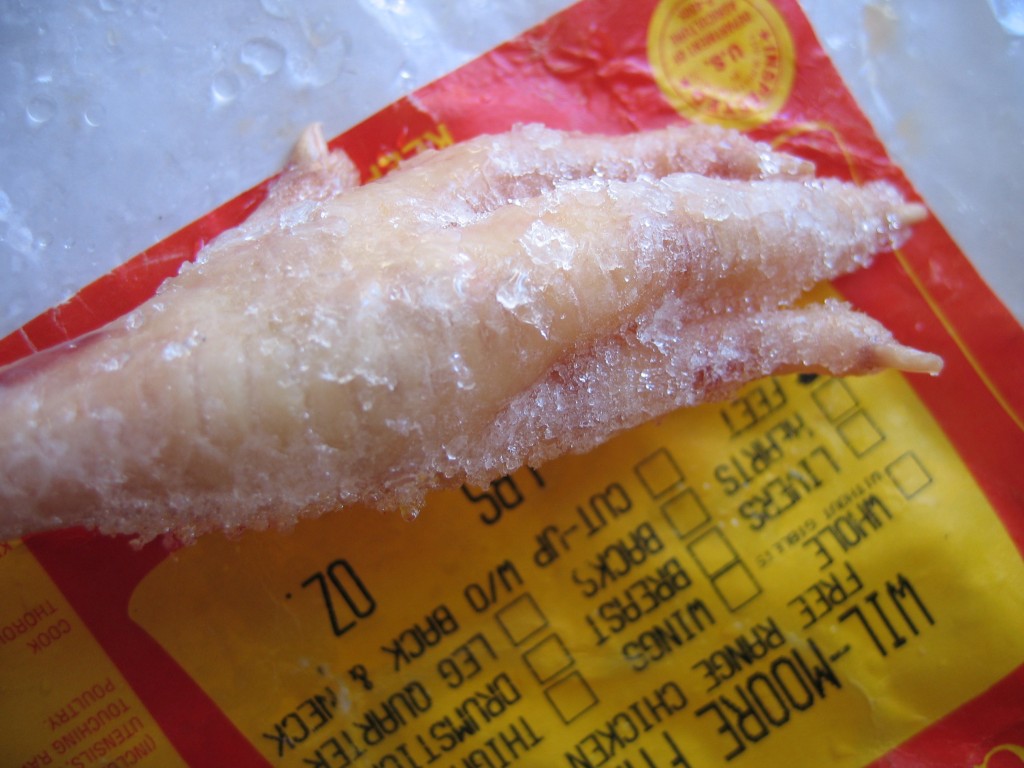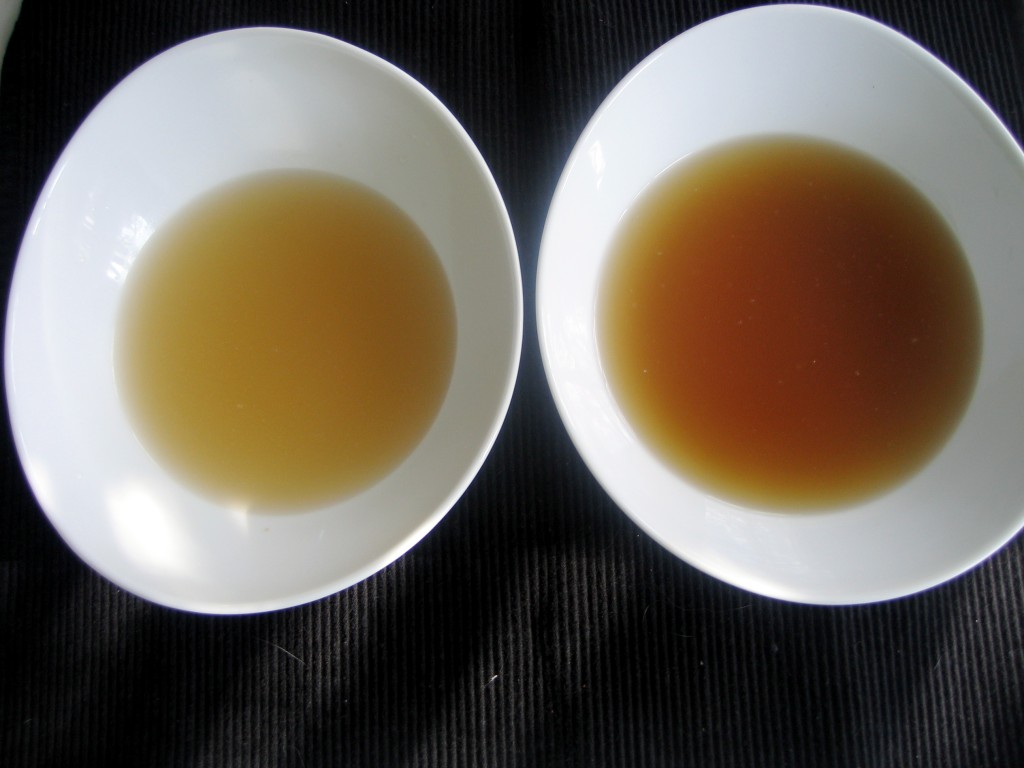Liquid Gold
 Since writing about why I cook, I’ve been thinking about the all the transformations inherent in cooking. In that post, I compare cooking to alchemy, the process of perfecting a base metal (lead) until it turns into a valuable commodity (gold). Making stock might be the best example of kitchen alchemy at work. It takes probably the basest of all ingredients- an old chicken carcass and vegetable scraps- and transforms them into liquid gold for your kitchen. Consommé, a type of clear stock, actually has the same root as “consummate”- both mean to bring something to perfection. Regardless of the metaphorical significance such a process may have, stock is a basic, if endangered, kitchen skill.
Since writing about why I cook, I’ve been thinking about the all the transformations inherent in cooking. In that post, I compare cooking to alchemy, the process of perfecting a base metal (lead) until it turns into a valuable commodity (gold). Making stock might be the best example of kitchen alchemy at work. It takes probably the basest of all ingredients- an old chicken carcass and vegetable scraps- and transforms them into liquid gold for your kitchen. Consommé, a type of clear stock, actually has the same root as “consummate”- both mean to bring something to perfection. Regardless of the metaphorical significance such a process may have, stock is a basic, if endangered, kitchen skill.
In the most recent Slow Kitchen meeting, we did a blind tasting between stock from a box and homemade stock. Homemade stock had a “spicier” aroma and “more flavors” than the “bland” and “thin” stock from a box. Homemade stock is rich experience all around, from the deep golden color to the unctuous complex flavor. Can you guess which is which?
Besides being a tasty base for soups, sauces, and gravies, stock is full of vitamins, minerals, and other healthy things like gelatin. Many others have written about the health benefits of a well prepared stock, including Sally Fallon, the author of Nourishing Traditions: The Cookbook that Challenges Politically Correct Nutrition and the Diet Dictocrats, so I won’t rewrite the wheel. Let’s just say there’s a reason chicken stock was called the “Jewish penicillin.”
I wanted to make stock for long time before I had the courage to do it. All the recipes I read sounded so intimidating. For one thing, they are always very long. And full of terms that not only was I unfamiliar with but seemed a little indecent for a respectable cookbook. All a recipe had to do was mention the word “carcass” and I was lost. What is a carcass? Is it the same as a whole chicken? Should there be any meat left on it? Does it matter what size? At that point in my culinary self-education, I was still very tied to recipes, so I was never sure when the recipe called for 3 to 8 pounds of chicken parts if the 2 1/2 pounds I had would still work. And honestly, does anyone actually know what “scum” is anyway? I never could seem to find a straight answer to that one. All of that, coupled with a fierce desire to become something of a domestic goddess, meant that I approached my first stock pot with the trepidation of a girl on her wedding night. That something wonderful was supposed to happen, I knew. But exactly how, well, I had no earthly idea.
Some time has passed since then. Like an old married woman, I now discuss the squimish topics of carcasses and scum with nary a blush. However, I realize there are still those stock virgins out there who need someone wise in the ways of stock making to frankly talk them through what’s going to happen.
What follows is my everyday recipe for chicken stock. Please don’t be intimidated by the length. I’ve tried to be as clear and detailed as I can. Making stock is as simple or as complicated as you want it to be. In the recipe, I give you both the “proper” technique and then what I actually do. At it’s most basic, think of it as similar to brewing tea. Tea leaves are placed in boiling water that, through the process of diffusion, extracts the goodness (flavor, aroma, caffeine, ect) trapped inside the leaves. To make stock, simply replace the tea leaves with chicken bones. So don’t be scared. It’ll all be okay. And at the end of it, you’ll have made something beautiful, perfect, and worth more than gold in kitchen currency.
(If you would like to make beef stock, put all your bones in a roasting pan and roast in an 350° oven until they are uniformly browned, about 90 minutes, stirring occasionaly. Then proceed with step one. Roasting the bones first sets in motion the Maillard reaction which produces deeper, more complex, umami flavors.)
- Put a chicken in a stock pot. The chicken can be a whole raw chicken, a whole carcass left over from a roast , or bones you’ve saved from other meals like fried chicken. Also, if you happen to have chicken feet, necks, gizzards, ect, throw those in too. They add more flavor and nutrition to your stock. The feet are special because they have a high gelatin content, which means there will be more gelatin in your stock. Once you get used to having quality stock around, you’ll probably intentionally buy these things. When I make a roast chicken, I’ll generally save the carcass in the freezer until I’m ready to make stock.
- Add a few tbs of vinegar. This helps extract the minerals, like calcium, from the bones. Then add water to cover the bones by several inches.
- Let sit for 30 minutes
- Bring water to a boil and skim off any foam that rises. Scum is . . . impurities. That’s the best I’ve been able to figure out. If you’d like, you can be a perfectionist about it and stand over your stock for 45 minutes skimming off every little bit of scum as it rises. Or, you can be lazy like me and wait till your pot looks like a dirty bubble bath, skim that off and call it good. You will want to skim at least the majority of the scum off as it can give your finished stock an off flavor. If you are using a whole chicken, you will have more scum than if you are just using a carcass.
- Add any veggies you want- I keep my vegetable scraps (carrot and onion tops, ect) in a bag in the freezer and add those plus an onion cut in half, maybe some celery, and another carrot broken in half. Please don’t spend time chopping them. It’s a waste of time. The only reasons to nicely chop vegetables are for aesthetics and even cooking times. These vegetables are going to be strained out at the end, so no one will see them but you. And the stock simmers for so long that everything will be thoroughly cooked, believe me. So put your knife away and just throw those celery sticks in the pot.
- Bring stock back to almost a boil and reduce heat to a bare simmer.
- If you are using a whole chicken, remove it after about an hour and remove the meat. Then put the carcass (bones, skin, everything else) back in the pot. You can then use the meat for chicken salads, chicken soup, enchiladas, tacos, ect. Removing it now, instead of at the end, keeps it from getting overcooked and rubbery.
- Simmer, covered, for at least 8 hours. 12 is better. 24 is sublime. It takes time to extract everything from the bones. While some recipes say its fine to simmer for only 3-5 hours, I think the resulting stock is not worth the effort. There are chefs that keep barrels of stock simmering for up to two weeks, so don’t be afraid of overcooking your stock. Do keep an eye on it, and stir occasionally. Add more water if it drops below the level of the bones. You can consider your stock done when the water is a deep golden color and you can crush a leg bone between your fingers. If you’re nervous about leaving the stove on over night, turn the burner off about an hour before you go to bed to let the stock cool. Then, right before bed, put it in the fridge. Then just start it again the next morning. If you have a large enough crock pot, you could also pour the stock into that once you’ve brought it to a simmer on the stove. I’ve also put my stock pot in a 200° oven and let it simmer away in there, leaving my stove top free for other cooking.
- When you’re done simmering, turn off the heat and dunk in a bunch of fresh parsley. The residual heat will be enough to extract the flavor from the parsley, but still leave a fresh flavor. Let the stock cool a little. Then use a large slotted spoon and strain out the big pieces of vegetable and bone. Then use a colander to strain the rest of the solids out. If you want a really clear stock (with no celery leaves or such), strain it again through a colander lined with cheese cloth or a tea towel (NOT terry cloth). I rarely do this. The little bits of leaves that remain in the stock don’t bother me. Store your stock in the fridge overnight. A good stock will gel solid, like Jello. Mine doesn’t always gel though. I don’t know why it’s not consistent. I’m experimenting with techniques, and when I get some conclusive evidence, I’ll let you know. For now, don’t worry. Your stock will still taste great and be nutritious even if it doesn’t gel solid.
- Take the stock out and skim off the solidified fat. This step is actually optional. Some people think it’s gross, but the fat is part of what contributes the rich flavor to stock. However, you don’t want it to be greasy. So normally, I’ll skim off most of it but not worry about the little shards that break off. I keep the skimmed fat in a jar in my fridge. You can use it to cook with or feed it to your cats. Just remember that it’s not as “pure” of a fat as butter, meaning there’s little bits of vegetable floating in it. Therefore, it won’t last as long as other fats. I’ve actually had it mold on me. So, use it within a couple of days.
- Now, you have several options for storage. You can use it right away for soup or some such thing. Or, you can store it in the fridge for about a week. (If you are going to do this, it’s best to not skim the fat, as this forms a barrier that will stop bacteria from getting in.) If you choose to refrigerate your stock, make sure you bring it back to a good rolling boil before using it, to kill anything that might be growing in there. Or, you can freeze it. If you have ample freezer space, store it however you store other liquids (tupperware, plastic bags, mason jars…) If you have limited space (like me), then you can put the skimmed stock back in the pot and reduce it to whatever volume you desire. You can reduce a whole batch of stock to fit in an ice cube tray and store it that way. I usually reduce it by about half.
- The last step is yours to decide. Spend your liquid gold in whatever way you choose. Make a delicious soup, a gravy for your mashed potatoes, or a sauce to put over your carrots. You can cook your rice or beans in it. Or even just drink a mug of it. Sound excessive? Believe me, it won’t once you’ve made your own stock. You’ll want to.
 This is a chicken foot. Yes, it looks like a foot. Get over it. It is also your secret weapon of stock making, producing a a rich golden stock full of gelatin.
This is a chicken foot. Yes, it looks like a foot. Get over it. It is also your secret weapon of stock making, producing a a rich golden stock full of gelatin.
 More chicken feet. Can you tell I’m trying to desensitize you so you won’t be afraid to go buy them?
More chicken feet. Can you tell I’m trying to desensitize you so you won’t be afraid to go buy them?
 This is what your stock should look like after a few hours. Pale chicken parts and flaccid celery not quite your style? Don’t worry. The liquid is what you’re after. It will turn a deep golden color before it’s done. Can you believe most recipes have you stop here?
This is what your stock should look like after a few hours. Pale chicken parts and flaccid celery not quite your style? Don’t worry. The liquid is what you’re after. It will turn a deep golden color before it’s done. Can you believe most recipes have you stop here?
 This is what your bones should look like when you’re done. Full of little holes, like those pictures of osteoporosis patients’ bones. All of the things that make bones strong have been leached out into your stock. Even major bones, like this leg bone, should crumble easily between your fingers.
This is what your bones should look like when you’re done. Full of little holes, like those pictures of osteoporosis patients’ bones. All of the things that make bones strong have been leached out into your stock. Even major bones, like this leg bone, should crumble easily between your fingers.
Tags: Chicken, Foodcraft, Kitchen skills, The Slow Kitchen, vegetables


Dangit! I just made some, and can you believe it I forgot to put some feet in there. Also I need to get in the habit of taking the meat out sooner. I’m sure it makes a huge difference.
Hey! What’s the best way to ‘reduce it by half’? and what do you think about canning this stuff?
Katie,
Sorry for the lateness of my reply. To reduce chicken stock, just keep boiling it uncovered. Evaporation will take care of the rest! I’ve never canned my chicken stock, but I know people who do. I just seem to go through it so fast that the extra step of canning isn’t worth it. I normally just freeze what I can’t use within a week. If you do start canning it, let me know how it goes!